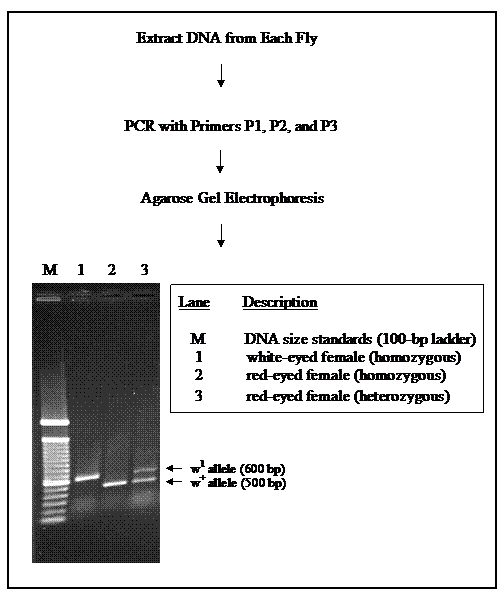| Background
The introductory cell biology and genetics course (Biology 203) at Hood College includes the use of Drosophila melanogaster to study the sex-linked inheritance of eye color which was discovered by Thomas Hunt Morgan in the early 1900’s. By crossing a white-eyed male with red-eyed females, Morgan and his students demonstrated that white eye is a recessive trait carried on the X chromosome. The inheritance of this Drosophila trait is used extensively as a classical lab exercise to demonstrate the concept of X-linked inheritance in undergraduate biology courses.
The white-eye mutation discovered by Morgan is caused by the insertion of a retroposon in the promoter region of the white (w+) gene. The w+ allele codes for a transport protein in the membrane of cells that directs the import of pigment precursors into the cytoplasm of eye pigment cells which are processed to produce the final “red” eyes observed in wild-type Drosophila. The mutation discovered by Morgan is designated white-one (w1) and is caused by the insertion of a 4,700-bp retroposon in the promoter region of the w+ gene. The insertion of this genetic element inactivates the promoter for the w+ gene and blocks expression of the pigment transporter protein. Thus, this recessive X-linked mutation produces white eyes in homozygous recessive females (Xw1Xw1) and affected males (Xw1Y).
To augment this Biology 203 lab activity, we are developing a polymerase chain reaction (PCR) method that will allow the genotyping of wild type (red-eyed) and mutated (white-eyed) flies. Incorporation of this genotyping exercise into our traditional investigation will provide students “hands-on” experience establishing the link between genotype and phenotype and will introduce them to common techniques used in molecular genetics, including the extraction of DNA, PCR, and agarose gel electrophoresis.
Development of Fly Genotyping Method Extraction of DNA
The results of our work have demonstrated that the choice of buffer for the extraction of fly DNA is critical. We have found that homogenizing each fly in 50 µl of “squishing buffer” (10 mM Tris, pH 7.2, 25 mM NaCl, 1 mM EDTA, 200 µg/ml proteinase K) is more reliable for the extraction of fly DNA than using a buffer composed of 10% Chelex.
The PCR method
We have been able to design and use a combination of three primers in a single PCR reaction that successfully genotypes this mutation in Drosophilia. Each PCR reaction contains 10 mM Tris (pH 8.3), 50 mM KCl, 1.5 mM MgCl2, 200 µM dNTP, 0.5 µM each primer (P1, P2, and P3), 5 µl fly DNA, 1.25 units of Taq DNA polymerase (Invitrogen Inc.) in a final volume of 50 µl. After overlaying each reaction mixture with 25 µl of mineral oil, amplifications are conducted in a PE 480 Thermal Cycler (Perkin-Elmer Corp.). After first heating at 94ºC for 2 minutes, samples are subjected to 35 cycles of denaturation at 94ºC for one minute, annealing at 55ºC for 1 minute, and extension at 72ºC for 2 minutes. A final step of 72ºC for 5 minutes is included to ensure DNA synthesis is completed.
As summarized in Figure 1, these conditions distinguish the genotypes of female flies, including those that are heterozygous for red eyes.
Figure 1. Summary of the fly genotyping method.

Spring Semester 2008
This semester we have 53 students enrolled in Biology 203, which includes three lab sections. We are in the process of integrating this PCR-based genotyping activity into our traditional Drosophila investigation, including the development of lab handouts for the students. These handouts will provide background information on the retroposon that is inserted in the promoter region of the white (w+) gene to produce the white-one (w1) mutation and the PCR genotyping method. In addition, the handouts will include a pre-lab activity that requires students to make predictions about the inheritance patterns as well as the PCR/electrophoresis banding products for eye color using the X-linked white-eyed mutation. Students will then begin supporting their predictions by doing the traditional fly crosses. Students will keep records of progeny from the F1 and F2 generations and do statistical analyses on their data as well as use their flies to run the PCR analysis to determine genotype of various F1 and F2 flies. Finally, we will use student surveys and feedback from two upperclassmen assisting with this project to evaluate the effectiveness of this lab exercise.
|
